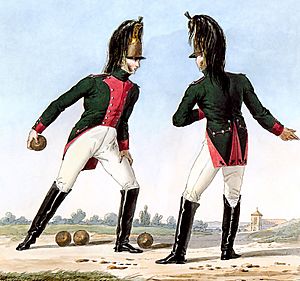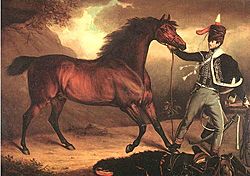Battle of Sahagún facts for kids
The Battle of Sahagún happened on December 21, 1808, in Sahagún, Spain. It was a fight between British and French cavalry during the Peninsular War. The British cavalry, especially the 15th Light Dragoons (Hussars), won a big victory. They defeated two French cavalry groups. One French group lost so many soldiers that it was later completely shut down. This battle was the last time the British army moved forward in Spain before they had to retreat to the coast.
Quick facts for kids Battle of Sahagún |
|||||||
|---|---|---|---|---|---|---|---|
| Part of the Peninsular War | |||||||
 A portrait of Henry, Lord Paget, later 1st Marquess of Anglesey, as Colonel of the 7th Light Dragoons (Hussars) circa 1807. |
|||||||
|
|||||||
| Belligerents | |||||||
| Commanders and leaders | |||||||
| Strength | |||||||
| 800 dragoons & chasseurs | 400 hussars This figure does not include the 10th Hussars |
||||||
| Casualties and losses | |||||||
| 20 killed & wounded 13 officers and over 300 other ranks captured |
4 killed 21 wounded |
||||||
Why the Battle Happened
The Peninsular War was a big conflict in Europe. It was fought between France and other countries like Spain, Portugal, and Britain. The Corunna campaign was part of this war.
Sir John Moore led a British army into Spain. His goal was to help Spain fight against the French army. But the French leader, Napoleon, had brought a huge army into Spain. The Spanish capital, Madrid, had also fallen to the French.
This meant the British army was in a very dangerous spot. Sir John Moore knew he had to retreat towards the coast. From there, his army could be taken away by ships. But before leaving, he wanted to attack a French army group nearby. This group was led by Marshal Jean-de-Dieu Soult.
As part of this plan, the British cavalry, led by Lord Paget, rode ahead. They were sent to check on Soult's forces. This led to the Battle of Sahagún.
Who Fought?
The French army had a cavalry group led by César Alexandre Debelle. It included about 800 soldiers from two types of cavalry: Chasseurs à cheval (light cavalry) and Dragoons (mounted infantry).
The British force was made of two cavalry groups called Hussars. These were the 15th Light Dragoons (Hussars) and the 10th Light Dragoons (Hussars). The 15th Hussars did most of the fighting.
The Battle of Sahagún
It was a very cold night. Lord Paget ordered his soldiers to move. He sent the 10th Hussars through the town of Sahagún. French cavalry were staying there. Lord Paget himself led the 15th Hussars around the town. His plan was to trap the French.
But the general leading the 10th Hussars, John Slade, was slow. The French cavalry realized the British were close. They quickly left the town to the east without being stopped.
As the sun came up, the French soldiers saw the 15th Hussars. They quickly formed two lines. The 1st Provisional Chasseurs were in front. The 8th Dragoons were behind them. The French cavalry waited for the British attack. They even tried to stop it by firing their carbines (short rifles).
The 15th Hussars charged forward. They rode about 400 yards over snowy, frozen ground. They shouted "Emsdorf and Victory!" This was a cheer for an earlier battle they had won. It was so cold that the soldiers wore their thick coats. Many had cloaks over everything. Their hands were so numb it was hard to hold their reins and swords.
When the British Hussars hit the French Chasseurs, it was a powerful crash. One British officer wrote that "horses and men were overthrown." He heard "a shriek of terror, intermixed with oaths, groans and prayers for mercy." The force of the British charge broke through the Chasseurs. They kept going into the Dragoons behind them.
The French army was completely broken. They ran away to the east, with the British chasing them. Many French cavalrymen were captured. The 15th Hussars had very few losses. Two French lieutenant colonels were captured. The Chasseurs lost so many men that they stopped being a fighting group. The 10th Hussars arrived during the chase. But they were first mistaken for French soldiers. This made the 15th Hussars stop their chase to regroup. This ended the battle.
What Happened Next
Sir John Moore's plan to attack Soult ended with the Battle of Sahagún. The main French armies were getting too close. Instead, the British army began a long and difficult retreat. This retreat ended with the Battle of Corunna at the port of A Coruña on the Spanish coast.
Moore's plan did work in one way. The British army's presence made Napoleon focus on them. This gave the Spanish forces time to get organized again after their defeats.
The victory of the 15th Hussars at Sahagún was important. After this battle, the French cavalry were not eager to fight the British cavalry again. The French 1st Provisional Chasseurs lost so many soldiers that they were completely disbanded.
The British Hussars won another victory later in the Corunna campaign. On December 29, 1808, at the Battle of Benavente, they defeated Napoleon's best cavalry. They pushed the Chasseurs à cheval of the Imperial Guard into the River Esla. They even captured their commanding general, Lefebvre-Desnouettes.
The 15th Hussars were given "Sahagun" as a special honor for this battle. This honor is still celebrated today by the Light Dragoons and B Battery Royal Horse Artillery.
See also
 In Spanish: Batalla de Sahagún (1808) para niños
In Spanish: Batalla de Sahagún (1808) para niños



